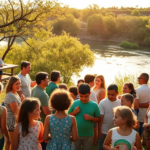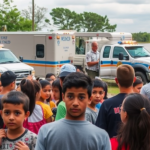**Severe Storms Ravage South Texas: Three Dead, Over 200 Rescued Amidst Historic Flooding**
Severe storms unleashed havoc in South Texas, leading to catastrophic flooding that claimed the lives of at least three individuals and necessitated the rescue of more than 200 people. These storms have trapped residents in their homes, compelled motorists to abandon vehicles on flooded roads, and resulted in the shutdown of a significant area airport.
**Historic Rainfall and Unified Response**
The city of Harlingen bore the brunt of the storm, receiving a record-breaking 21.5 inches of rain, overshadowing a historical record set back in 1912. Mayor Norma Sepulveda characterized the flooding as both historic and challenging, yet reaffirmed her confidence in the community’s enduring resilience. “This, of course, has been a historic and challenging event for the city. But Harlingen is strong. We have faced adversity before and we will get through this together,” she stated during a Friday news conference.
Rescue operations were promptly launched across various South Texas towns. The city of Alamo witnessed more than 100 water rescues as emergency services devotedly worked to assist residents stranded in vehicles and homes by the deluge. In Weslaco, around 30 to 40 rescues were conducted, showcasing the dire circumstances many faced due to the persistent rainfall.
**Impact Extends Across the Valley**
Cameron County was among the hardest hit, receiving over 17 inches of rain. Consequently, county officials have petitioned Governor Greg Abbott for a disaster declaration, underscoring the extensive impact of the deluge across the region. Eddie Treviño Jr., Cameron County Judge, emphasized the gravity of the situation, noting on social media, “The rainfall amounts we received have been record-setting, and not in a good way. All county resources are being utilized right now, and we are assisting in all ways possible.”
The severe weather prompted the temporary closure of the Valley International Airport in Harlingen, while over 20 school districts were compelled to cancel classes. Though flood warnings were still active, the National Weather Service indicated a temporary respite from the rain, highlighting that isolated thunderstorms remain a concern.
**Community and Infrastructure Challenges**
As families struggle to cope with the impact, community shelters have been established in affected areas, such as Alamo and Weslaco. Despite the storm’s subsiding, officials stress that emergency responses and disaster recovery efforts are ongoing. Fire Department Chief R.C. Flores of Alamo highlights this ongoing need for action: “Just because the storm is over, it doesn’t mean that the emergencies and the disaster are over. We are going to continue to work as long as we need to.”
Power outages compounded the difficulties faced by many, leaving more than 3,400 individuals across several South Texas counties without electricity. Floodwater has caused damage to infrastructure, leaving hazardous conditions on roads and prompting schools and businesses to close in the storm’s aftermath.
**Looking Ahead: Recovery and Future Precautions**
The severe flooding illuminates a broader pattern of weather extremes that have beleaguered South Texas in recent years. The Federal Emergency Management Agency (FEMA) and other federal and state authorities may be required to step in further as the regions begin the lengthy process of recovery.
Looking forward, conversations about improving infrastructure resilience to such weather events are likely to gain momentum. This might involve reevaluating urban planning strategies to enhance drainage systems and prevent similar flooding in the future.
For residents eager to contribute to ongoing recovery efforts, there are opportunities for volunteers with local aid organizations such as the Red Cross, as well as forthcoming community meetings organized by local councils dedicated to planning and relief efforts.
In this moment of crisis, the response from local authorities, emergency services, and the community at large epitomizes the enduring spirit and solidarity of South Texas. While recovery efforts push forward, the lessons learned from these storms may lead to better preparedness and understanding of the environmental challenges that the Rio Grande Valley faces.
**Community Resources and Contact Information**
Residents affected by the storms or those desiring to assist in relief efforts can contact local authorities or visit community centers for updates and resources. The National Weather Service remains a valuable resource for ongoing weather updates, available online and across social media platforms. Public information sessions and workshops will be instrumental in keeping the community informed about relief and recovery activities.
In a region repeatedly tested by nature, the tenacity and resolve of Valley residents continue to shine. As the floodwaters slowly recede, the focus will shift toward healing and advancing collective resilience against future challenges.







